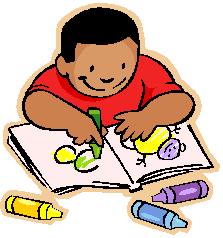
One Thing Leads to Another

Lesson Three
Overview: Sometimes called "stories without words," wordless picture books convey meaning through the illustrations. Encourage kids to develop the narrative by prompting them with starters, such as "and then..." or "when suddenly the..." or "and finally..." The list is endless. Wordless books are excellent tools for helping children develop the basic building blocks of language. Wordless picture books stimulate creativity and language, while at the same time introducing a child to basic story structures and the contribution of art to literature. A wordless book stretches the imagination, allowing children to explore language through design and illustration. The layout of picture is such that it helps children develop eye coordination and print awareness.
In this lesson the students improve their reading and comprehension skills by reading their own words. Students create sequential stories that are meaningful to them; they draw a series of pictures to tell a simple sequential story that includes character action, problem and resolution.
Duration: Two or three class periods
Objectives:
Students will write a story which will correspond to their own sequential drawings.
Students will match their writing to correspond with their drawings.
Students will identify details in wordless picture books which help them tell a story.
Materials:
Book Tuesday by David Wessner, writing material, art supplies. Unit Resources
Activities:
Reading activities should focus on "what happens next" to characters and how story plot leads to problems and solutions.
This activity may require wait-time for certain students and one-to-one teacher/student interaction. While teacher is helping the students put their books together other activities can be included for students to engage in while they wait for the teachers' individual attention.
Gather students together and tell the students that this book only contains pictures, it has no words, so they are going to tell the story themselves. Have students share their ideas and tell the story page by page by randomly selecting students. Point out details from the illustrations and ask story element questions to help students with their imagination.
Explain that the assignment is for them to draw their own picture book story. Clarify that the reader must be able to tell what the pictures mean and they must be in a sequential order. Five pictures will be the required amount of pages for their wordless picture books. When finished drawing they need to put the drawings in order.
Write on the board a sentence from which their stories could start such as" One day....." or "Once Upon a Time." also write down transitional words such as NEXT, AFTER THAT, and THEN.
After their illustrations are completed and placed in sequential order an accordion book is created and students will share with the entire class by telling us their stories aloud while displaying their art work.
Assessment:
Teacher observation and student's sequential illustrations finished product.
Home Learning:
Students can write a story which corresponds with the illustrations they created during the class activity.
Extension: visit website to create own story.
http://riverdeep.net/language_arts/edmark_lang_arts/MakeAStory/MakeAStory.html
Back to Main Page